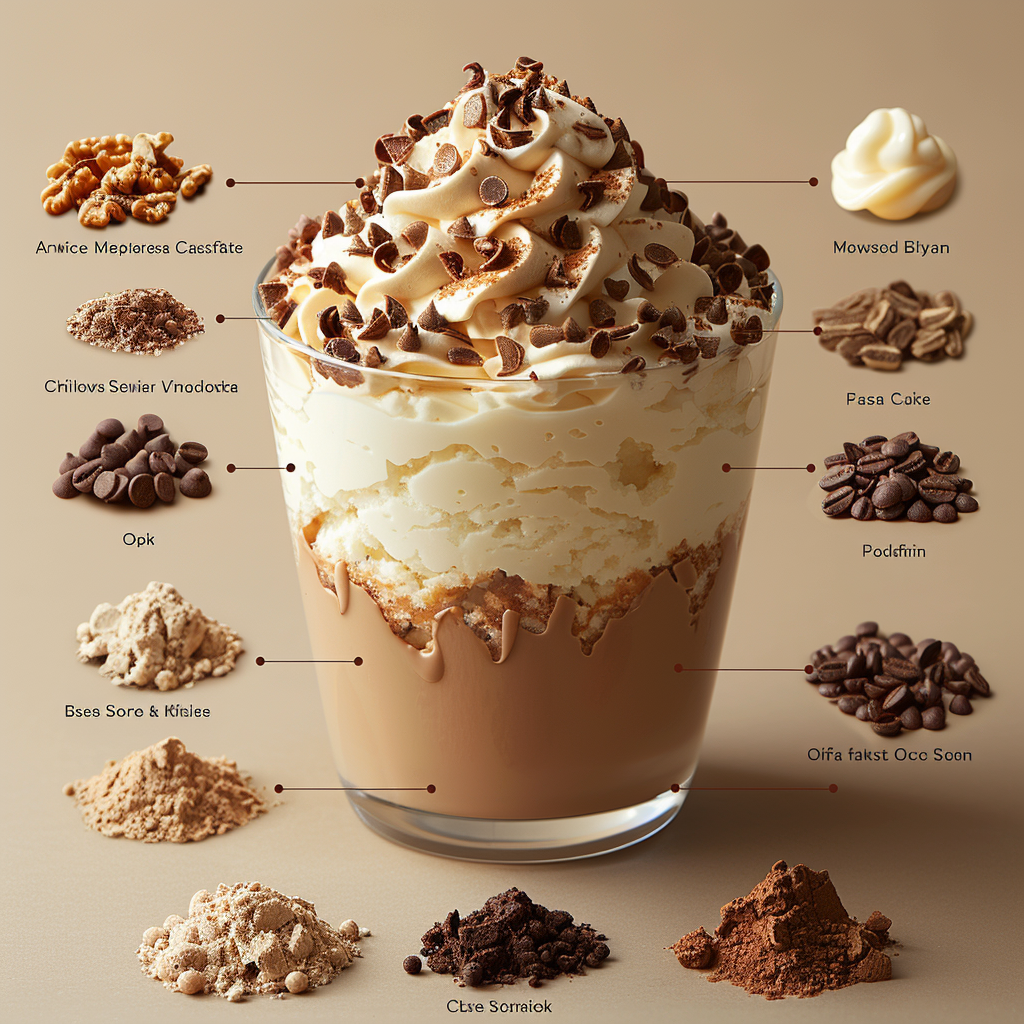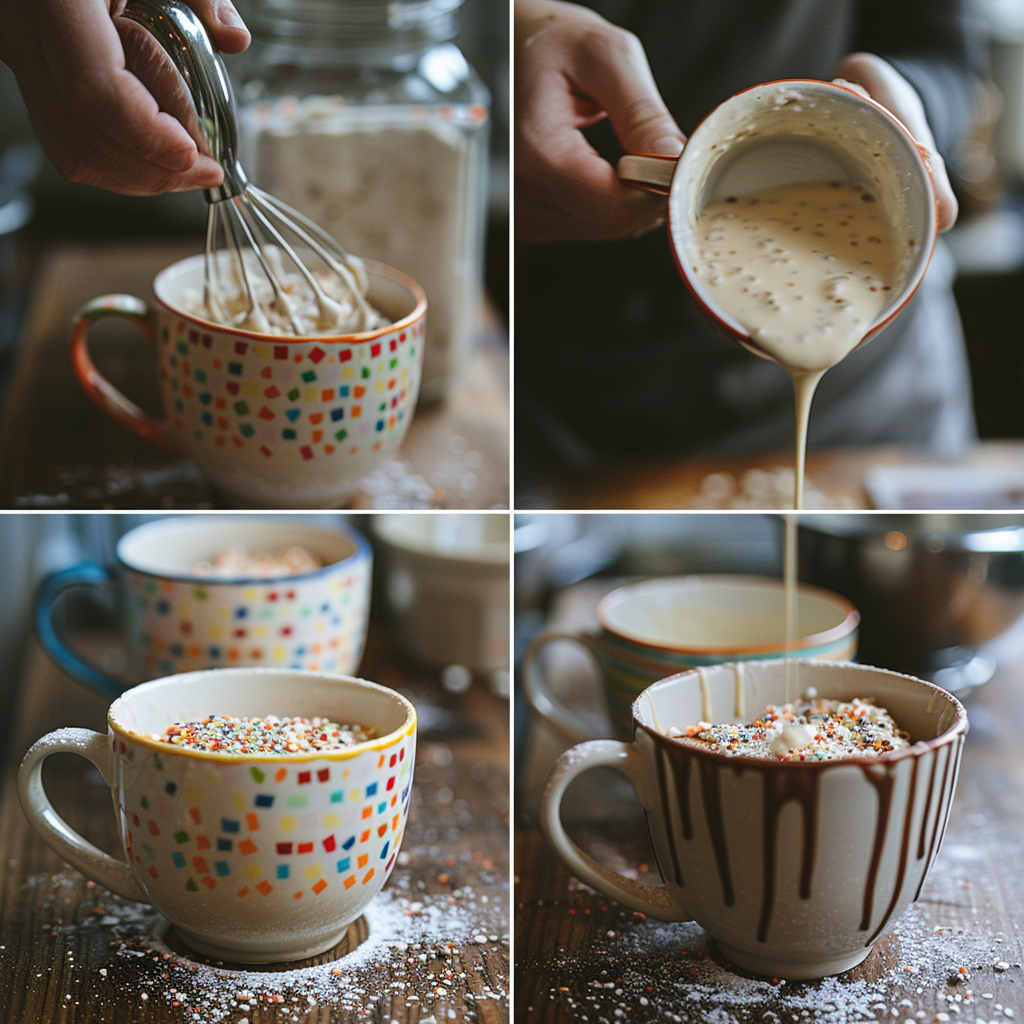Introduction
Have you ever eagerly whipped up a mug cake, only to find it dense, rubbery, or far from the light, spongy delight you envisioned? It’s a frustrating scenario that many baking enthusiasts encounter. Mug cakes are supposed to be quick, delicious, and hassle-free, yet several factors can derail their texture. This article dives deep into the common causes of why your mug cake isn’t spongy, while offering expert advice, actionable fixes, and pro tips to help you bake the perfect one every time.

Part 1 :Common Causes of a Dense Mug Cake
Overmixing the Batter.Why is my mug cake not spongy ?
Overmixing the batter is one of the most common pitfalls. When you stir too vigorously or for too long, you develop too much gluten. While gluten is necessary for structure, excess gluten creates a dense and chewy texture that’s far from the spongy result you want. Instead, aim for a gentle mix just until the ingredients are combined. Overworking the batter could ruin the balance.
Incorrect Ingredient Ratios
The ratio of wet to dry ingredients is critical to a mug cake’s texture. Too much flour or too little liquid can lead to a dry, dense cake. Similarly, insufficient leavening agents like baking powder or soda can prevent the cake from rising properly, resulting in a heavy, stodgy finish. Measuring ingredients precisely is key, as even a small deviation can make a big difference in single-serving recipes like mug cakes.
Overcooking in the Microwave
Microwaves work quickly, but they can be unforgiving. Cooking a mug cake for too long often leads to a rubbery, overcooked texture. Unlike traditional baking, microwave heat is uneven, causing some areas to cook faster than others. To avoid this, experiment with shorter cooking times, starting with 30 seconds, and adding 5-10 seconds as needed until the cake is just set.
Part 2 :Mixing Methods
Proper Mixing Techniques
Why is my mug cake not spongy ? The way you mix your mug cake batter can make or break its texture. Overmixing isn’t the only problem—undermixing can also leave you with lumps of flour or unevenly distributed ingredients. A gentle hand is essential. First, combine the dry ingredients in a small bowl or the mug itself to ensure an even distribution. Then, add the wet ingredients and stir gently until the mixture is just smooth. Avoid vigorous mixing, which can overdevelop gluten, leading to a tough cake.
The Impact of Mixing Order
The order in which ingredients are combined plays a surprisingly big role in your mug cake’s success. For instance, mixing wet and dry ingredients separately before combining ensures a smoother batter. When you dump everything into the mug all at once, it’s easy to miss pockets of unmixed flour or uneven distribution of sugar. Start by whisking the egg and liquid ingredients together, then add the dry ingredients gradually. This method ensures a uniform batter and a more consistent texture in the final cake.
Part 3 :Mug Selection
Choosing the Right Mug Size and Material
Believe it or not, the mug you use can significantly influence your cake’s texture. A mug that’s too small can cause the batter to overflow, while an overly large mug may lead to uneven cooking. Choose a standard-sized ceramic mug that holds about 12–16 ounces. Material matters too: ceramic mugs retain heat more evenly than glass or plastic, reducing the risk of overcooking or undercooking certain areas. Additionally, make sure your mug is microwave-safe to avoid accidents.
Recipe Adjustments
Adjusting Recipes for Altitude and Humidity
Environmental factors such as altitude and humidity can subtly affect your mug cake. At higher altitudes, air pressure decreases, causing cakes to rise more quickly and then collapse. To combat this, reduce the amount of leavening agent slightly and add an extra tablespoon of liquid. Conversely, in humid climates, flour absorbs moisture from the air, potentially throwing off the wet-to-dry ratio. Store flour in an airtight container, and consider reducing liquids slightly to balance things out.
Troubleshooting and Solutions
Identifying and Correcting Common Mistakes
It’s easy to make small mistakes when whipping up a quick mug cake, but fortunately, most are fixable. If your cake isn’t spongy, start by reviewing the basics: Did you measure ingredients accurately? Did you overmix or microwave it too long? If the cake is overly dense, try reducing the amount of flour slightly or ensuring your leavening agents are fresh. For a rubbery texture, shortening the cooking time or reducing egg content might help. Always test adjustments one at a time to pinpoint the cause.
Testing for Doneness Without Overcooking
Knowing when your mug cake is done is key to avoiding a dry or rubbery result. A simple way to check is by gently pressing the surface of the cake—if it springs back, it’s ready. Alternatively, insert a toothpick into the center; if it comes out clean or with a few moist crumbs, the cake is done. Stopping the microwave a few seconds early and allowing the residual heat to finish the cooking can also prevent overcooking.
Enhancing Flavor and Texture
Incorporating Moisture-Rich Ingredients
Adding ingredients that boost moisture can elevate your mug cake from ordinary to extraordinary. Try incorporating a tablespoon of yogurt, sour cream, or applesauce into the batter. These ingredients not only enhance moisture but also contribute to a softer crumb. Even small additions like a teaspoon of oil or melted butter can make a noticeable difference in achieving a perfectly spongy texture.
Experimenting with Different Flours
The type of flour you use can greatly affect your mug cake’s texture. All-purpose flour is the most common choice, but experimenting with alternatives like almond flour or oat flour can yield interesting results. Almond flour tends to produce a denser cake, while oat flour adds a chewy texture. If gluten is a concern, consider a gluten-free blend specifically designed for baking. Just remember to adjust liquids slightly, as different flours absorb moisture differently.
Part 4 : Frequently Asked Questions
Why is my mug cake rubbery?
A rubbery mug cake often results from overcooking, too much egg, or overmixing the batter. Stick to the recommended cooking time and consider reducing the egg or replacing it with a substitute like applesauce for a softer texture.
Can I make a mug cake without eggs?
Yes! Many recipes work well without eggs. You can use substitutes like mashed banana, yogurt, or flaxseed mixed with water to maintain moisture and structure.
How can I make my mug cake fluffier?
For a fluffier texture, ensure your leavening agents are fresh, and don’t overmix the batter. Adding a tablespoon of whipped cream or yogurt can also improve the cake’s lightness.
What’s the best size for a mug cake mug?
A mug with a capacity of 12–16 ounces is ideal. It prevents the batter from overflowing while ensuring even cooking. Always choose a microwave-safe mug.
Why does my mug cake collapse?
Collapsing can occur if there’s too much leavening agent or if the cake is undercooked. Reduce the baking powder slightly and ensure the cake is fully set before removing it from the microwave.
Can I make a vegan mug cake?
Absolutely! Vegan mug cakes are simple to prepare by using plant-based milk, oil, and egg substitutes like flaxseed or applesauce.
Part 5 : A Foolproof Mug Cake Recipe
Ingredients
Here’s a simple recipe to create a spongy, flavorful mug cake. Gather the following ingredients:
- 4 tablespoons all-purpose flour (or a gluten-free alternative)
- 2 tablespoons granulated sugar (adjust to taste)
- 1/4 teaspoon baking powder (ensure it’s fresh)
- A pinch of salt
- 2 tablespoons milk (or a plant-based alternative)
- 1 tablespoon vegetable oil or melted butter
- 1/2 teaspoon vanilla extract
- Optional: 1 tablespoon chocolate chips or fruit for added flavor
Step-by-Step Instructions
- Mix the Dry Ingredients:
In a microwave-safe mug, combine the flour, sugar, baking powder, and salt. Stir with a fork to ensure they’re evenly distributed. - Add the Wet Ingredients:
Add the milk, oil, and vanilla extract to the dry ingredients. Stir gently until the batter is smooth and no lumps remain. Be careful not to overmix. - Incorporate Optional Ingredients:
If you’re adding chocolate chips, nuts, or fruit, gently fold them into the batter. This step is optional but can enhance both flavor and texture. - Microwave the Batter:
Place the mug in the microwave and cook on high for 60–90 seconds. Start with 60 seconds and check for doneness. If needed, microwave in 10-second increments until the cake is set in the center. - Let it Rest:
Allow the mug cake to cool for 1–2 minutes before digging in. This rest time lets the heat distribute evenly, ensuring the perfect texture.
Part 6 :Final Tips for the Perfect Mug Cake
Experimentation Leads to Perfection
Not all mug cake recipes work perfectly on the first try, and that’s okay. Each ingredient you tweak and every adjustment you make brings you closer to mastering your ideal mug cake texture. For example, if your cake consistently turns out too dry, try adding a tablespoon of sour cream or yogurt. If it doesn’t rise enough, slightly increase the baking powder or switch to a self-rising flour. Baking, even in a mug, is as much an art as it is a science!
Make It Your Own
Mug cakes are wonderfully versatile. You can make them your own by adding a personal twist. A sprinkle of cinnamon, a spoonful of peanut butter, or a handful of crushed nuts can completely transform your mug cake. For a healthier option, consider using whole wheat flour, coconut sugar, or a touch of honey instead of granulated sugar. The possibilities are as endless as your imagination!
Takeaways and Encouragement
Crafting the perfect mug cake may seem challenging, but with patience and the right approach, it’s entirely achievable. By understanding the common pitfalls—like overmixing, overcooking, and imbalanced ingredient ratios—you can troubleshoot effectively and elevate your mug cake game. Whether you’re aiming for a decadent chocolate mug cake or a light vanilla treat, the tips shared here will ensure you achieve the fluffy, spongy results you desire.
Common Mug Cake Variations to Try
Mug cakes are a canvas for creativity. By tweaking the base recipe, you can create countless variations to suit your mood or dietary needs. Here are some fun and delicious ideas to experiment with:
Chocolate Lover’s Mug Cake
Add 1 tablespoon of cocoa powder to the base recipe and reduce the flour by the same amount. Stir in a few chocolate chips for extra indulgence, or drizzle with melted chocolate after cooking for a rich, fudgy treat.
Peanut Butter Bliss Mug Cake
Swirl 1 tablespoon of peanut butter into the batter just before microwaving. The result? A nutty, creamy delight with bursts of peanut butter in every bite. For added crunch, sprinkle crushed peanuts on top.
Healthy Banana Mug Cake
Replace half the sugar with mashed banana for natural sweetness and a boost of potassium. Add a pinch of cinnamon and a handful of chopped walnuts for a flavor-packed, healthier option.
Lemon Poppy Seed Mug Cake
For a zesty twist, substitute vanilla extract with 1/2 teaspoon of lemon juice and stir in 1/2 teaspoon of poppy seeds. This refreshing variation is perfect for spring or summer cravings.
Vegan Mug Cake
Skip the egg and replace milk with almond, soy, or oat milk. Use 1 tablespoon of applesauce, mashed banana, or flaxseed mixed with water as an egg substitute. The result is a moist and spongy cake without any animal products.
Part 7: Tips for Storing and Reheating Mug Cakes
Can You Store Mug Cakes?
While mug cakes are best enjoyed fresh, they can be stored for short periods. Cover the mug with plastic wrap or transfer the cake to an airtight container to keep it moist. Store in the refrigerator for up to 24 hours.
How to Reheat Mug Cakes
To reheat, microwave the cake for 10–15 seconds. Be cautious, as reheating too long can dry out the cake. If needed, add a splash of milk before reheating to restore some moisture.
Mug Cake Troubleshooting Recap
If your mug cake still isn’t spongy after trying the tips in this article, consider these quick fixes:
- Double-check the freshness of your baking powder or soda.
- Measure ingredients carefully—precision is key for single-serve recipes.
- Experiment with cooking times based on your microwave wattage.
- Avoid overmixing the batter; stir until ingredients are just combined.
- Test different mugs to find the one that cooks your cake most evenly.
Remember, baking is a learning process. Each trial teaches you something new about your technique or equipment. With persistence and creativity, you’ll soon master the art of crafting perfect mug cakes every time.

